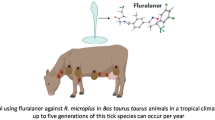Abstract
In a 4 ha area, of which 1/3 was meadow vole habitat, the old vole runways were spot treated in early spring with a 1% spray of flowable Sevin® 4F (42% AI) on ca 4 m centers. New runways, as noted, were treated in June. The application averaged 60 ml of Sevin® 4F/ha. The spring adult cohort ofDermacentor variabilis was <10% of that usually expected. These adults had been exposed to this treatment the previous year as spring larvae and summer nymphs. The reduction of the adult population occurred in a season of heavy infestation.
This treatment is not labor intensive and requires only a minimum of pesticide because it is directed to its target, the attached immatures, by the behavior of the field mice. It should be noted that all the small rodent hosts of the immatures use the vole runways.
Zusammenfassung
In einem 4 ha großen Areal, von dem die Wiesenwühlmaus ein Drittel nutzte, wurden im zeitigen Frühjahr die alten Wühlmaus-Wege auf 4-m-Abschnitten mit 1%igem SEVIN® AF (42% AI) besprüht. Die neuen Laufwege wurden im Juni behandelt. In beiden Fällen betrug die Aufwandmenge 60 ml/ha. Die Population der frühjahrs-adulten Zecken wurde um mehr als 20% reduziert. Diese Adulten waren der vorjährigen Behandlung der Wege als Larven und Nymphen ausgesetzt. Die Verminderung der Adulten-Population fand in einer Saison starken Zeckenbefalls statt. Gegenmaßnahmen dieser Art kommen mit einem Minimum an Pestiziden aus, da sie die Parasiten direkt treffen. Alle kleinen Nagetiere—als Wirte der Zecken—verwenden die Wühlmaus-Laufwege.
Similar content being viewed by others
Literature Cited
McEnroe, W.D., 1979:Dermacentor variabilis (Say) in eastern Massachusetts. Rec. Adv. in Acarology2, 145–153.
McEnroe, W.D., 1986: Regulation of the American dog tick,Dermacentor variabilis (Say) (Acari, Ixodidae) two cohort population in the coastal area of Massachusetts. J. Appl. Ent.102, 370–379.
McEnroe, W.D., 1987: The relationship between the size of the spring adult cohort ofDermacentor variabilis Say (Acari, Ixodidae) and its parental breeding season under relaxed winter regulation. J. Appl. Ent.104, 531–532.
McEnroe, W.D.;Specht, H.B., 1985: Age effect analysis ofDermacentor variabilis adult populations during seasonal activity (Acari, Ixodidae). Can. J. Zool.65, 455–457.
Sonenshine, D.E.;Haines, G., 1985. A convenient method for controlling populations of the American dog tick,Dermacentor variabilis (Acari: Ixodidae), in the natural environment. J. Med. Ent.22, 577–583.
Author information
Authors and Affiliations
Additional information
With one figure
Rights and permissions
About this article
Cite this article
McEnroe, W.D. Control of the American dog tick,Dermacentor variabilis Say (Acarina: Ixodidae). Anz. Schadlingskde., Pflanzenschutz, Umweltschutz 63, 48–50 (1990). https://doi.org/10.1007/BF01903464
Issue Date:
DOI: https://doi.org/10.1007/BF01903464




